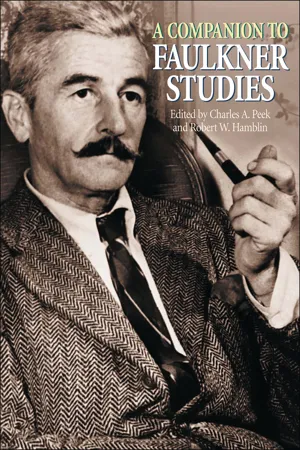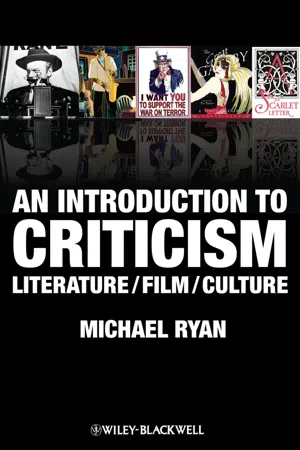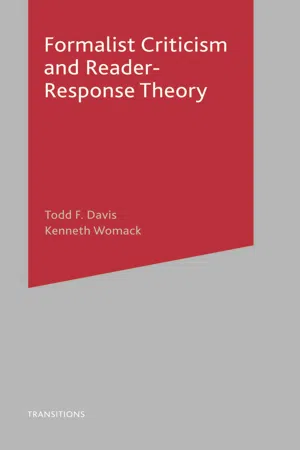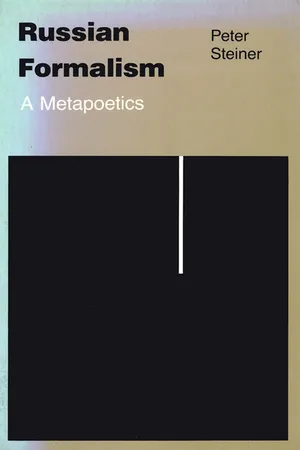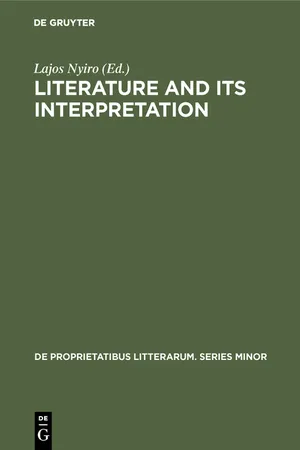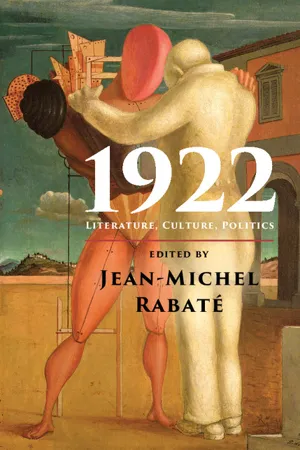Literature
Formalism Literary Theory
Formalism literary theory emphasizes the intrinsic structure and form of a literary work, focusing on elements such as language, style, and literary devices rather than external factors like historical or biographical context. It seeks to analyze the text as a self-contained entity, highlighting the significance of form in conveying meaning and aesthetic value.
Written by Perlego with AI-assistance
Related key terms
1 of 5
9 Key excerpts on "Formalism Literary Theory"
- eBook - PDF
- Charles Peek, Robert W. Hamblin, Charles Peek, Robert W. Hamblin(Authors)
- 2004(Publication Date)
- Greenwood(Publisher)
These critical works all take as a methodolog- ical given the attention paid to formal aspects of the texts, but such a definition can, of course, be applied to any critical approach; in some respects, then, the issue is one of emphasis or degree. I have tried to limit my scope to those stud- 48 A COMPANION TO FAULKNER STUDIES ies which emphasize the form of the work and the ways the work's parts con- tribute to its overall effect, keeping in mind that the distinction between form and content is blurry at best, as is that between form and style. Formalism has been defined, theoretically speaking, as finding meaning and value in the text itself and, accordingly, regarding matters such as context, recep- tion, or biography as extraneous. In practice, few followers of formalist method- ology disregard all factors outside the realm of form and style. What formalists do look for are structural relationships and patterns in words, phrases, sen- tences, and larger units of discourse. This is what ties together such seemingly incompatible approaches as New Criticism, structuralism, poststructuralism, deconstruction, narratology, and Bakhtinian readings. I have chosen these as the most important categories within formalism for Faulkner studies, keeping in mind that many other critical approaches make use of formalist methods and that the terms formalism and form have come to be considered old hat, or even relatively useless, within some critical circles. 1 It is hard to ignore the impor- tance, however, of these various formalist approaches, particularly in the field devoted to an author so interested in style, narrative complexity, structure, gaps and surplus, and the power of the sentence. NEW CRITICISM AND RELATED FORMALISMS Many critics have noted the importance New Criticism has had for the "res- urrection" of Faulkner's literary prestige, as well as the ways in which Faulkner's reputation reinvigorated New Criticism itself. - Mads Rosendahl Thomsen, Lasse Horne Kjældgaard, Lis Møller, Lilian Munk Rösing, Peter Simonsen, Dan Ringgaard, Mads Rosendahl Thomsen, Lasse Horne Kjældgaard, Lis Møller, Lilian Munk Rösing, Peter Simonsen, Dan Ringgaard(Authors)
- 2017(Publication Date)
- Bloomsbury Academic(Publisher)
Formalism Formalism is generally divided into early Russian formalism (1914–1927) and later Czech formalism (1928–1948). The formalists focused on formal devices and functions. They considered art a field with specific laws that can be described and that have an effect on the reader, with a particularly divergent use of language. Formalism is an aesthetics, in the word’s original meaning of sensory learning, and not a hermeneutics, that is involving learning through interpretation. Here Viktor Shklovsky’s (1893–1984) concept of defamiliarization is central. Our perception of the world is automated, which means that we do not see the world, but our expectations of the world, and art should therefore defamiliarize by expressing things in an alternative and apparently strange way. It leads us via detours to see the world in a different light. This is generally done by breaking the automatic and pragmatic connection between language and the world. In terms of language, this break is seen on a literary historical level as a break with tradition. Art is conditioned by history, but it evolves through breaks where the new does away with the old. In Roman Jakobson’s concept of the poetic function, signs refer to the world, but first and foremost to themselves and thus to the difference between themselves and the world. Furthermore, by entering into patterns conditioned by other signs, they indicate that meaning emerges between signs, and not just between signs and things. Here and in Vladimir Propp’s investigations of plot structures in folk tales, formalism anticipates structuralism. It has also had a major influence on New Criticism. Formalism shared the joy of facts and method with the futurists and the Russian avant-garde, cf. Shklovsky’s manifesto from 1914. Russian literary philosopher Mikhail Bakhtin (1895–1875) criticized formalism for its consideration of language and art in isolation and outside the context of society.- eBook - PDF
An Introduction to Criticism
Literature - Film - Culture
- Michael Ryan(Author)
- 2011(Publication Date)
- Wiley-Blackwell(Publisher)
6 Formalism way characters are constructed, the way lyrics are chosen and arranged, the structure of the melody, the placement of the camera, the kind of lighting used, the images chosen to illustrate points, and the like. In order to mean, cultural works must have a formal dimension that consists of carefully chosen and arranged techniques. Formalists in literary study were initially concerned primarily with poetry because poetry is so different from ordinary speech. It is clearly formed, made different by being arranged differently. It possesses rhythm and rhyme; it has melody and depends often on phonic harmony created by alliteration or the repetition of sounds. “Poetics” is the term for the formal study of poetry. The formal analysis of a poem begins with a simple non-judgmental and non-interpretive description of the work. It describes the themes, the setting, the speaker or narrator, the characters if any, the implied world of the poem (what precedes the poem and what follows), the structure of the poem, such as the breakdown into stanzas, the genre or type of poem, the meter used (such as iambic pentameter), the rhyme scheme, the emotional movement of the poem toward a climax if any, the repetition of words, the images used, the figurative language such as metaphors and symbols, the congruence or dissonance of sounds in alliteration and assonance, the overall thematic argument as that is worked out in the language, etc. Here are websites that will provide you with most of the important terms to use in such a basic description: http://www.infoplease.com/spot/pmglos- sary1.html; http://www.factmonster.com/ipka/A0903237.html. Formalists are also concerned with rhetoric, the shape a writer gives to thoughts or themes in various language constructions. Rhetoric consists of more complex forms of speech or writing that writers use. - Todd Davis, Kenneth Womack(Authors)
- 2018(Publication Date)
- Red Globe Press(Publisher)
While form and content cannot be parsed from one another and clearly form has a direct impact upon meaning, nonetheless, formalist critics do not choose indiscriminately the forms they praise. Instead, humanist principles appear to direct the critic in the kinds of art studied and the elements praised. ‘The whole story is the meaning,’ Flannery O’Connor declares, ‘because it is an experience, not an abstraction’ ( Mystery and Manners 73), and the experiences that formalist critics doggedly seek after tend to be those that carry the reader toward a contemplation of human struggles and triumphs, emotional toil and joy. The limits of formalism: Universalism, eclecticism, and morality in the work of F. R. Leavis and Kenneth Burke In Literary Criticism: A Short History (1978), Brooks and Wimsatt describe the distinction between art and science and the bridge criti-cism and poetry may offer in negotiating this chasm of difference: We can have our universals in the full conceptualized discourse of science and philosophy. We can have specific detail lavishly in the newspapers and in records of trials. . . . But it is only in metaphor, and hence it is par excellence in poetry, that we encounter the most radi-cally and relevantly fused union of the detail and the universal idea. (479) 2 8 A C r i t i c a l I n t r o d u c t i o n It is this grasping after the universal that inevitably led to the demise of formalism in general and New Criticism in particular. While during the first half of the twentieth century most did not condemn the desire of critics to find what might offer universal connection between humans and their cultures – a dominant modernist perspec-tive – the critical practice that emerged from this desire became a tool for British and American dominance and an easy target of critique from more socially oriented forms of criticism like Marxism, femi-nism, and reader-response theory.- eBook - PDF
- Antonio García-Berrio(Author)
- 2016(Publication Date)
- De Gruyter(Publisher)
The formal analysis of a literary and poetic text, beyond being absolutely feasible and relatively easy and accessible, guarantees the possibility of veri-fying in artistic texts the existence of certain structural constants which characterize aesthetic intentionality. Don Quijote or Las Meninas are not what they are in the fulfillment of the free play of some consensual fad. There is something in those great works of art, in the most immanent and material structures of their composition, which places them safely beyond any whim-sical and irresponsible forms of consensually and culturally ascribed value. The formalist methodology already offers us a secure basis, in the breadth and depth of its experience of conceptual categories and analytical strategies for making those constants evident in the text, the necessary effects and results of which testify to the fact that artistic texts acquire a characteristic sense precisely because they participate in a system of aesthetic universals, within the context of which their special features are substantially explained. In the evolution of formalist methods two principle paths need to be distinguished depending on the class of texts being analyzed, each with its own markedly characteristic evolution. In its first period, the work of Russian formalism established, above all, the structural characteristics of the new Russian poetry (A. Garcia-Berrio, 1973, pp. 101 — 198). In a certain sense, as we have already explained, the school thus made its entrance as a continuation of the traditional rhetorical analysis of poetic texts. Studies of prose, which we are not lacking in this initial period of the school's evolution, basically coincide in their orientation with poetic analyses, given that the works of Gogol, Tolstoy and even Lenin were examined as artistic prose (B. Eikhenbaum, 1922). - eBook - PDF
Russian Formalism
A Metapoetics
- Peter Steiner(Author)
- 2016(Publication Date)
- Cornell University Press(Publisher)
The princi-ple that literature should be treated as a specific series of facts is too general to distinguish either the Formalists from non-For -malists, or genuine Formalists from fellow travelers. A similar concern was voiced by earlier Russian literary scholars, and the autonomy of literary facts vis-a-vis other phenomena was nev er solved by the Formalists themselves. Neither did they agree on what the specific properties of the literary material are or how the new science should proceed from them. The epistemological diversity of this new literary science be-comes obvious when we compare those who wer e methodologi-cally similar, for example, the two leading Formalist students of verse, Tomasev skij and Jakobson. The former, rebutting the charge that the Formalists shirk the basic ontological issues of literary studies (that is, what literature is), wrote: I shall answer by comparison. It is possible to study electricity and yet not know what it is. And what does the question, 'what is electricity,' mean anyway? I would answer: 'it is that which, if one screws in an electric bulb, will light it.' In studying phenomena one does not need an a prio ri definition of essences. It is important only to discern their manifestations and be aware of their connections. This is how the Formalists study literature. They conceive of poetics precisely as a discipline that studies the phenomena of literatu re and not its essence.16 Jakobson, in contrast, argues that such an ad hoc procedure was the modus operandi of old-fashioned literary scholarship. Until now, the literary historian has looked like a policeman who, in trying to arrest a person, would, just in case, grab every-one and everything from his apartment, as well as accidental passers-by on the street. To pursue accidental phenom ena in-stead of the literary essence is not the correct way to proceed, Jakobson insisted. - eBook - PDF
- Lajos Nyiro(Author)
- 2019(Publication Date)
- De Gruyter Mouton(Publisher)
5 66 L. NYfRO thinking of the time. In the solution of its tasks in the field of literary scholarship it kept pace with the new propositions of the natural and the social sciences by reviving the methodologi-cal devices of literary studies. The formalists rejected the prac-tice built upon subjectivist and spiritualist judgments ingrained in the study of literature, and cherished the scientific ideal that the intricate complex of the phenomena of literature can be unravelled, analysed and interpreted by exact scientific methods. They were inventive in examining the structure of poetic language and poetic works, while their artistic sense also proved very refined. They created a scientific model of the work of art, and thus a new channel for the evolution of modern literary scholarship. This stated, we should not, however, overestimate the theoretical contributions of the Russian Formalist School. We must not forget that, as regards its philosophical foundations, the School repre-sented, in the last analysis, an idealist trend. The idealist and agnostic aspects of their outlook are apparent especially where they delimit-ed the existence of the work of art from non-literary phenomena. At the same time, we also have to admit that the delimitation of the artistic work from historical conditions, from social life, the formulation of the immanency principle, proved to be an histori-cally necessary and important hypothetical method. Only thus could they conceive of the artistic work as a model. The uprooting of the literary work from the social basis, the one-sided negation of the social genesis of the work of art, however, entailed con-sequences such as the carrying to absurd lengths of the immanency principle of literature (Tynyanov's experiment remained in an embryonic stage and came too late to resolve this rigid delimit-ative principle) which necessarily drew the formalists into conflict with the cultural revolution of the twenties. - eBook - PDF
- Herbert Grabes, H. J. Diller, Hans Bungert(Authors)
- 2020(Publication Date)
- De Gruyter(Publisher)
ROGER D. SELL The Drama of Fictionalized Author and Reader: A Formalist Obstacle to Literary Pragmatics I Some of the most influential linguists and philosophers of the twentieth century have been suspicious of language as people ordinarily use it. The whole enterprise of post-Saussurean linguistics was to abstract langue from the messiness of parole, and Bertrand Russell's motives for trying to refine a purer language of formal logic were well understood by the logical positivists. They felt that ordinary speech was too loose, imper-fect and metaphysically loaded, and that even higher debate—philo-sophical, theological, ethical, aesthetic—was often largely meaningless as well. A somewhat similar suspicion of ordinary language can be detected in the formalism of many of the period's literary scholars. Here, ordi-nary language or the language of science was felt to be insufficiently complex for sensitive and sophisticated expression. The language of lit-erature, on the other hand, was a special, deviant language, which set up an aesthetic heterocosm whose complex tensions, paradoxes, ambiguities and ironies quite surpassed the crass monoideism of our more mundane existence. Indeed, the literary text was somehow no longer even felt to be addressed by a man to men. The poem did not mean. It simply was. And all discussion of the author's intention and of the impact on the reader was ruled out as psychologistic fallacy. The literary work was said to be, not pragmatic, but dramatic: a dramatization of a relation-ship between a fictionalized speaker and a fictionalized reader. Discussion of a poem's real genesis was said to have only the weak-est foundation. We ought to impute the thoughts and attitudes of the poem immediately to the dramatic speaker, and if to the author at all, only by an act of biographical inference (Wimsatt, 5). - eBook - PDF
1922
Literature, Culture, Politics
- Jean-Michel Rabaté(Author)
- 2015(Publication Date)
- Cambridge University Press(Publisher)
Literature, in other words, renews itself in a complex process of succession that is driven by differential percep- tions of what is or is intended to be literary. For Shklovsky, consistent with Formalism’s initial focus on securing “autonomy and concreteness for the discipline of literary studies” (Eikhenbaum 1970, 3), this is an essentially closed system; or, at least, in the absence of a suitably scientific method that will facilitate an alternative, it is necessary or desirable to proceed ini- tially as if it were a closed system. At the level of the individual work, this general theory of literary change supports and justifies the contention – unrepentantly repeated by Shklovsky as late as 1921 – that the literary work is “pure form,” so long as “form” is understood as the totality of the “orientation of materials” orga- nized in it by its devices (2000, 317). More than the ostensibly compelling case of “poetic language,” more than the theory of the device in isolation, it is, perhaps paradoxically, the reconfiguration of these elements in the context of an attempt to construct a theory of literary change – we can- not yet say “history” – that emerges as the most unrepentantly Formalist of all these projections. Yet this, too, although it plays a crucial formative role in the mature theory of literary evolution that will displace it, does not survive in anything like its originary form after Shklovsky’s departure in 1922. In fact, this process of evolution toward a theory of evolution was sub- stantially underway before Shklovsky’s departure, dating from the direct involvement in Opoiaz – both theoretical and organizational – of Iurii Tynianov from 1919.
Index pages curate the most relevant extracts from our library of academic textbooks. They’ve been created using an in-house natural language model (NLM), each adding context and meaning to key research topics.
